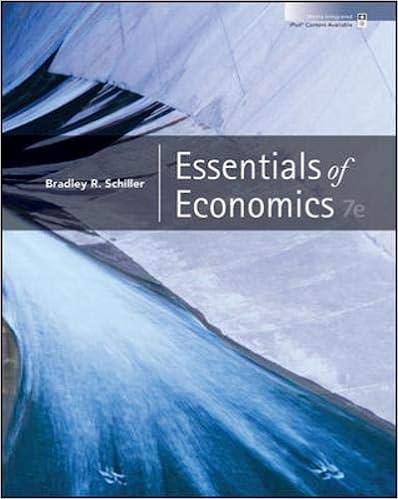Question
1)What is the marginal net benefit of producing the fourth unit? No. units produced Total Revenue Total Costs 0 0 0 1 100 50 2
1)What is the marginal net benefit of producing the fourth unit?
No. units produced Total Revenue Total Costs
0 0 0
1 100 50
2 180 110
3 250 180
4 290 270
5 310 380
2) Suppose total benefits and total costs are given by B(Y) = 600Y 12Y2and C(Y) = 20Y2. What level of Y will yield the maximum net benefits? Hint: marginal benefit = 600 - 24Y and marginal cost = 40Y.
3) Suppose market demand and supply are given by Qd= 100 - 2P and QS= 5 + 3P. The equilibrium quantity is:
4)Suppose the demand for good X is given by Qdx= 10 - 2Px+ Py+ M. The price of good X is $1, the price of good Y is $10, and income is $100. Given these prices and income, how much of good X will be purchased?
5) Suppose the own price elasticity of demand for good X is 0.25, and the quantity of good X increases by 5 percent. What would you expect to happen to the total expenditures on good X?
6) Suppose that a consumer's preferences are well behaved in that properties 4-1 to 4-4 are satisfied and the initial equilibrium consumption bundle consists of 100 units of X and 50 units of Y. If PXdecreases such that the new equilibrium consumption bundle is 150 units of X and 75 units of Y, then goods X and Y are: substitutes, complements, unrelated, or inferior? Explain your reasoning.
7) Mitchell's money income is $150, the price of X is $2, and the price of Y is $2. Given these prices and income, Mitchell buys 50 units of X and 25 units of Y. Call this combination of X and Y bundle J. At bundle J, Mitchell's MRS is 2. At bundle J, if Mitchell increases consumption of Y by 1 unit, how many units of X must he give up in order to satisfy his budget constraint?
8) If the annual interest rate is 0 percent, the present value of receiving $1.10 in the next year is:
9) What is the maximum amount of good X that can be purchased if X and Y are the only two goods available for purchase and Px= $10, Py= $20, Y = 5, and M = 400?
10) Suppose market demand and supply are given by Qd= 100 - 2P and QS= 5 + 3P. If a price ceiling of $17 is imposed, what will be the resulting full economic price?
Step by Step Solution
There are 3 Steps involved in it
Step: 1

Get Instant Access to Expert-Tailored Solutions
See step-by-step solutions with expert insights and AI powered tools for academic success
Step: 2

Step: 3

Ace Your Homework with AI
Get the answers you need in no time with our AI-driven, step-by-step assistance
Get Started


